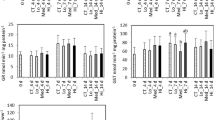Abstract
The water-soluble fraction (WSF) of crude oil is a complex highly volatile and toxic mixture of hydrocarbon chains (polyaromatics, heterocyclics), phenols, and heterocyclic compounds containing nitrogen and sulfur. To evaluate the toxic effects of WSF in tropical freshwater teleosts and to develop methodologies that could investigate the toxic mechanisms of WSF in tropical organisms, an acute toxicity experiment was conducted with Astyanax sp. Three dilutions (15%, 33%, and 50%) of WSF obtained from Campos Bay’s crude oil (Brazil) were used to study morphological and biochemical responses of the fish. Prior to exposure, the distribution and rate of volatilization of the WSF into each aquarium for the same exposure period was quantified by spectrofluorimetry. Five individuals of Astyanax sp. were exposed to duplicate WSF of 0, 15, 33, and 50% for each of 12-, 24-, and 96-h exposures for a total of 120 individuals. Liver and gills were sampled from five fish from each treatment and were analyzed by histology, scanning and transmission electron microscopy. A fragment of muscle was also collected from each fish to measure acetylcholinesterase activity. Water analysis showed that only 4 h after dilution, an important loss of hydrocarbons in 33% and 50% of WSF was observed. In addition, 50% of hydrocarbon mass was lost in all tested dilutions after 24 h with significant difference for the 50% WSF at all measured times, demonstrating the high volatility of WSF in freshwater. Damage in the liver and the gills included the presence of necrosis, loss of hepatocytes limit, inflammation areas, cellular proliferation, aneurysms, and disorganization of the second lamellae. The 33% WSF significantly reduced acetylcholinesterase activity in fish. Our study demonstrated that the WSF of crude oil caused damage in organs and tissues of tropical freshwater Astyanax sp. and provided also the basis for a better understanding of the toxic mechanisms of WSF in freshwater fishes.
Similar content being viewed by others
Author information
Authors and Affiliations
Rights and permissions
About this article
Cite this article
Akaishi, ., Silva de Assis, ., Jakobi, . et al. Morphological and Neurotoxicological Findings in Tropical Freshwater Fish (Astyanax sp.) After Waterborne and Acute Exposure to Water Soluble Fraction (WSF) of Crude Oil. Arch Environ Contam Toxicol 46, 244–253 (2004). https://doi.org/10.1007/s00244-003-2260-1
Issue Date:
DOI: https://doi.org/10.1007/s00244-003-2260-1




